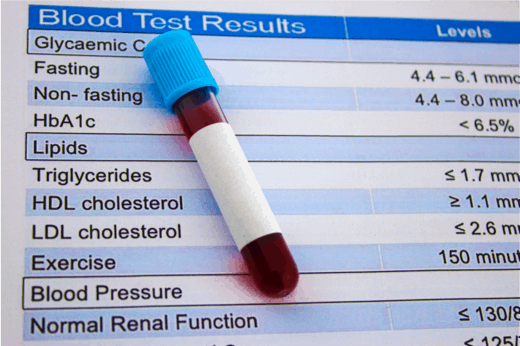High Cholesterol
Doctors tend to test a patient’s cholesterol level from time to time because there is a documented link between high cholesterol levels and the risk of cardiovascular disease.
There are several components that together make up the blood cholesterol level, the two major components being LDL (low density lipoprotein) and HDL (high density lipoprotein). High levels of LDL cholesterol increase the risk of cardiovascular disease, whereas high levels of HDL cholesterol are protective, and as such people often refer to LDL as the “bad” cholesterol, and to HDL as the “good”. These days doctors also talk about non-HDL cholesterol, a measure of LDL plus the other unhealthy components in the blood.
Patients frequently ask what a normal cholesterol level is, but the ideal cholesterol level varies from person to person and depends largely on whether the patient is already known to have vascular disease in the form of angina, a prior heart attack, TIA or stroke, or documented atheroma in the arteries supplying the heart, brain, or legs. These patients fall into the category of secondary prevention, where the risk of further heart attack, stroke or death is reduced by about 20% for each 1 mmol/L the LDL cholesterol is lowered with statin therapy and changes in lifestyle. In particular statins stabilise plaque within the blood vessel wall, rendering them less prone to rupture, the mechanism behind a heart attack. Some statins are particularly potent and may actually halve the risk of a future cardiovascular event.
High levels of HDL cholesterol are protective to the cardiovascular system, and women in particular tend to have higher levels. Some women have especially high levels such that the total cholesterol is high, but primarily due to the “good” HDL cholesterol, and as such, the total cholesterol level should never be looked at in isolation since this may be misleading. HDL increases modestly with regular exercise and sensible eating habits, and progress is being made to find drugs which raise the HDL cholesterol and produce cardiovascular benefit, analogous to statins which lower the LDL cholesterol and improve outcome over time.
Cholesterol levels increase gradually with age, but obesity, lack of exercise, poor diet and diabetes mellitus are also known contributors to higher levels. Some patients, however, have a purely genetically determined high cholesterol level, familial hypercholesterolaemia, where there are mutations in the genes which regulate the clearance of LDL cholesterol from the blood. Familial hypercholesterolaemia causes premature atherosclerosis and heart disease, and as it is due to an abnormal dominant gene, first degree relatives (siblings, parents and children) have a 50% chance of inheriting it. It greatly increases the risk of heart attack at a young age, and so screening is important; the advent of genetic testing and developments in screening tools have improved our ability to detect carriers of the gene at a young age and begin treatment early to reduce their risk of future heart problems.

Related links:
Symptoms - Chest Pain
Chest pain has a variety of causes, one of the most important of course being pain from the heart. Read more
Conditions - Coronary Artery Disease and
Angina
Coronary artery disease is the term given to soft fatty deposits or hard calcified plaques within one or more of the coronary arteries, the vessels which supply blood to the heart. Read more
Conditions - Heart Attack
Heart disease and diseases of the circulatory system are the leading cause of death in the UK, with one third of all deaths occurring from cardiovascular disease. Read more
Tests - CT Coronary Angiography
CT scanning uses a series of two-dimensional X-ray images taken from a single axis of rotation to build a three-dimensional picture of an area of the body. Read more
Treatments - Medical Therapy: High
Cholesterol
Statins are one of the most commonly prescribed drug classes worldwide, given to hundreds of millions of patients across the globe. Read more